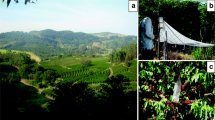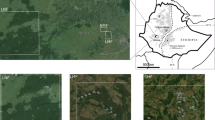Abstract
Arboreal ants form patchy spatial patterns in tropical agroforest canopies. Such patchy distributions more likely occur in disturbed habitats associated with lower ant diversity and resource availability than in forests. Yet, few studies have quantitatively examined these patchy patterns to statistically test if ants are non-randomly distributed or at what scale. Coffee agroecosystems form a gradient of management intensification along which vegetative complexity and ant diversity decline. Using field studies and a spatially explicit randomization model, I investigated ant patchiness in coffee agroecosystems in Chiapas, Mexico varying in management intensity to examine if: (1) coffee intensification affects occurrence of numerically dominant ants, (2) numerical dominants form statistically distinguishable single-species patches in coffee plants, (3) shade trees play a role in patch location, and (4) patch formation or size varies with management intensity. Coffee intensification correlated with lower occurrence frequency of numerically dominant species generally and of one of four taxa examined. All dominant ant species formed patches but only Azteca instabilis was patchy around shade trees. Ant patchiness did vary somewhat with spatial scale and with strata (within the coffee layer vs around shade trees). Patchiness, however, did not vary with management intensity. These results provide quantitative evidence that numerically dominant ants are patchy within the coffee layer at different scales and that shade tree location, but not coffee management intensity, may play a role in the formation of patchy distributions.


Similar content being viewed by others
References
Adams ES (1994) Territory defense by the ant Azteca trigona—maintenance of an arboreal ant mosaic. Oecologia 97:202–208
Armbrecht I, Perfecto I, Vandermeer J (2004) Enigmatic biodiversity correlations: ant diversity responds to diverse resources. Science 304:284–286
Davidson D (1998) Resource discovery versus resource domination in ants: a functional mechanism for breaking the trade-off. Ecol Entomol 23:484–490
Davidson DW, Cook SC, Snelling R, Chua TH (2003) Explaining the abundance of ants in lowland tropical rainforest canopies. Science 300:969–972
Dejean A, Djieto-Lordon C, Durand JL (1997) Ant mosaic in oil palm plantations of the southwest province of Cameroon: impact on leaf miner beetle (Coleoptera: Chrysomelidae). J Econ Entomol 90:1092–1096
Djieto-Lordon C, Dejean A (1999) Tropical arboreal ant mosaics: innate attraction and imprinting determine nest site selection in dominant ants. Behav Ecol Sociobiol 45:219–225
Floren A, Linsenmair KE (2000) Do ant mosaics exist in pristine lowland rain forests? Oecologia 123:129–137
Floren A, Freking A, Biehl M, Linsenmair KE (2001) Anthropogenic disturbance changes the structure of arboreal tropical ant communities. Ecography 24:547–554
Forel A (1899) Biologia Centrali-Americana; or, contributions to the knowledge of the fauna and flora of Mexico and Central America. Insecta. Hymenoptera. 3 (Formicidae). London
Hölldobler B, Wilson EO (1990) The ants. Harvard University Press, Cambridge, Massachusetts
Lachaud JP, García-Ballinas JA (2001) Diversité de la myrmécofaune (Ponerinae et Cerapachyinae) dans les agrosystèmes de café et cacao au Mexique. Insectes Soc 14:95–99
Leston D (1973) The ant mosaic—tropical tree crops and the limiting of pests and diseases. PANS 19:311–341
Longino JT (2002) Ants of Costa Rica homepage (http://www.evergreen.edu/ants/genera/camponotus/species/novogranadensis/novogranadensis.html)
Majer JD (1978) The maintenance of the ant mosaic in Ghana cocoa farms. J Appl Ecol 13:123–144
Majer JD, Queiroz MVB (1993) Distribution and abundance of ants in a Brazilian subtropical coffee plantation. P N G J Agric For Fish 36:29–35
Majer JD, Delabie JHC, Smith MRB (1994) Arboreal ant community patterns in Brazilian cocoa farms. Biotropica 26:73–83
Mas AH, Dietsch TV (2003) An index of management intensity for coffee agroecosystems to evaluate butterfly species richness. Ecol Appl 13:1491–1501
Moguel P, Toledo VM (1999) Biodiversity conservation in traditional coffee systems of Mexico. Conserv Biol 13:11–21
Perfecto I, Vandermeer J (1996) Microclimatic changes and the indirect loss of ant diversity in a tropical agroecosystem. Oecologia 108:577–582
Philpott SM, Armbrecht I (2006) Tropical agroforests and the ecological role of ants. Ecol Entomol (In press)
Philpott SM, Perfecto I, Vandermeer J (2006) Effects of management intensity and season on arboreal ant diversity and abundance in coffee agroecosystems. Biodivers Conserv 15:139–155
Ribas C, Schoereder J (2002) Are all ant mosaics caused by competition? Oecologia 131:606–611
Room P (1975) Relative distributions of ant species in cocoa plantations in Papua New Guinea. J Appl Ecol 12:47–62
Soares SM, Schoereder JH (2001) Ant-nest distribution in a remnant of tropical rainforest in southeastern Brazil. Insectes Soc 48:280–286
Theunis L, Gilbert M, Roisin Y, Leponce M (2005) Spatial structure of litter-dwelling ant distribution in a subtropical dry forest. Insectes Soc 52:366–377
Vandermeer J, Perfecto I, Ibarra-Nunez G, Philpott S, Garcia-Ballinas JA (2002) Ants (Azteca sp.) as potential biological control agents in organic shade coffee production in Southern Chiapas, Mexico: complication of indirect effects. Agrofor Syst 56:271–276
Acknowledgements
J. Maldonado, J.A. García-Ballinas, G. López, B.E. Chilel, J.C. Méndez López, A. Méndez Mendizábal, A. Hammond, F.B. Camposeco Silvestre, J.L. Cabrera Santos, F. Hernández Gómez, S. Uno, and P. Bichier helped with data collection. G. Estabrook and D. Schoolmaster helped with development of the models. J. Vandermeer, I. Perfecto, R. Burnham, B. Rathcke, and P. Bichier commented on the manuscript. The Peters and Edelman families, the owners of Guadalupe Zajú, and the ISMAM Cooperative allowed us to work on their farms. G. Ibarra-Núñez, J.A. García-Ballinas, and G. López from El Colegio de la Frontera Sur in Tapachula provided logistical support. This research was supported by NSF grant #DEB-9981526, Helen Olsen Brower Fellowship in Environmental Science of the University of Michigan, and NSF Graduate Research Fellowship to SP. The experiments comply with the current laws of the country in which they were performed.
Author information
Authors and Affiliations
Corresponding author
Rights and permissions
About this article
Cite this article
Philpott, S.M. Ant patchiness: a spatially quantitative test in coffee agroecosystems. Naturwissenschaften 93, 386–392 (2006). https://doi.org/10.1007/s00114-006-0123-0
Received:
Accepted:
Published:
Issue Date:
DOI: https://doi.org/10.1007/s00114-006-0123-0




